Observing ARDEX2023, Yogyakarta Indonesia ~Crucial process for integrating EMT SOP into ASEAN SASOP~
The ASEAN Regional Disaster Emergency Response Simulation Exercise (ARDEX-23) was held in Yogyakarta, Indonesia, from August 1 to 4, 2023. The event was jointly organized by the AHA Centre (ASEAN Coordinating Centre for Humanitarian Assistance on Disaster Management) and Indonesia’s National Disaster Management Authority (Badan Nasional Penanggulangan Bencana), as the host country. Related information: ARDEX-23
ARDEX is a comprehensive simulation exercise designed to test, practice, and review regional emergency response mechanisms. Held every two years, the exercise is jointly organized by the host country’s national disaster response agency and the AHA Centre. Its primary objective is to evaluate and implement procedures for regional emergency relief operations conducted by Urban Search and Rescue (USAR) teams. These procedures are tested and practiced in accordance with the regulations of the affected country along with the ASEAN Standard Operating Procedure for Regional Standby Arrangements and Coordination of Joint Disaster Relief and Emergency Response Operations (SASOP).
ARDEX was first held in Malaysia in 2005 under the ASEAN Agreement on Disaster Management and Emergency Response (AADMER), which was established in response to the widespread devastation caused by the 2004 Sumatra Earthquake and Tsunami. As the first regional disaster management agreement in the world, AADMER has facilitated the development of various regional frameworks. Through successive iterations, ARDEX has continually identified and proposed the need for following regional frameworks and standard procedures. Following Cyclone Nargis in Myanmar in 2008, the ASEAN Standard Operating Procedure for Regional Standby Arrangements and Coordination of Joint Disaster Relief and Emergency Response Operations (SASOP) was developed. This procedural framework was designed to enable coordinated emergency response efforts among multiple agencies, initially focusing on the involvement of Urban Search and Rescue (USAR) teams and military units in disaster response. However, during the extension phase of the ARCH project, discussions emerged about the necessity of incorporating emergency medical response into this framework. Consequently, the project worked on developing a standard operating procedure for international emergency medical teams—the ASEAN SOP for Emergency Medical Teams (EMT SOP). While efforts have been made to integrate the EMT SOP into SASOP, the validation process has been delayed due to the spread of the recent infectious diseases, so, awaited an appropriate opportunity for implementation.
At ARDEX-23, an emergency medical team (EMT) deployment exercise was conducted as the final validation step before the formal integration of the EMT SOP into SASOP. This exercise was included as the fifth objective among the seven established goals of the event:
- 1 . Test the integration of the national coordination mechanism (MAC Centre) with regional coordination protocols/mechanisms (JOCCA) & regional countries as well as international organizations for a joint response;
- 2 . Realization of increased understanding of the roles and functions of the National Focal Point for speed of response;
- 3 . Verify civil and military response and resource mobilization procedures;
- 4 . Realization (draft/input) for the ASEAN regional contingency in supporting affected countries;
- 5 . Test and validate the EMT SOP (SASOP Chapter VII);
- 6 . To test and review the Term of Reference (TOR) for the Secretary-General as the ASEAN Humanitarian Assistance Coordinator (SG-AHAC) and interoperability with all relevant sectors and stakeholders;
- 7 . To test and validate the ARDEX Referee Handbook
However, only two countries—Thailand and the Philippines—participated EMTs for this exercise. These two nations tested and assessed the EMT SOP by coordinating their deployment and operations with the affected country, as well as collaborating with USAR teams and other agencies.
The exercise was conducted using three methods: a Tabletop Exercise (TTX), a Command Post Exercise (CPX) , and a Field Exercise (FTX).

【Tabletop Exercise (TTX)】
The tabletop exercise was structured into three phases, covering the entire disaster response process from the onset of the disaster to the conclusion of international assistance:
- 1 . Domestic Disaster Response (Phase 1) – The initial response within the affected country (Indonesia in this case).
- 2 . International Coordination for ASEAN Assistance (Phase 2) – The request, acceptance, and deployment of ASEAN support teams under SASOP.
- 3 . Conclusion of International Assistance (Phase 3) – The withdrawal of international response teams.
During each phase, participants examined the operational mechanisms and the roles of relevant personnel. Participants included representatives from the AHA Centre, the ASEAN Secretariat, Indonesia’s disaster management agencies—including the National Disaster Management Office (NDMO), military, Ministry of Foreign Affairs, and Ministry of Health—as well as NDMOs from nine ASEAN member states, ASEAN-ERAT, and UNDAC.
The exercise focused on verifying key procedures, including Indonesia’s request for assistance, ASEAN member states’ applications to provide aid, coordination mechanisms managed by the AHA Centre, the ASEAN Secretariat, and UNDAC, as well as the withdrawal process for response teams such as USAR and EMT.
Following this verification process, it was confirmed that the ASEAN SOP for EMT would be integrated into SASOP without modifications, following the necessary ASEAN procedural approvals.
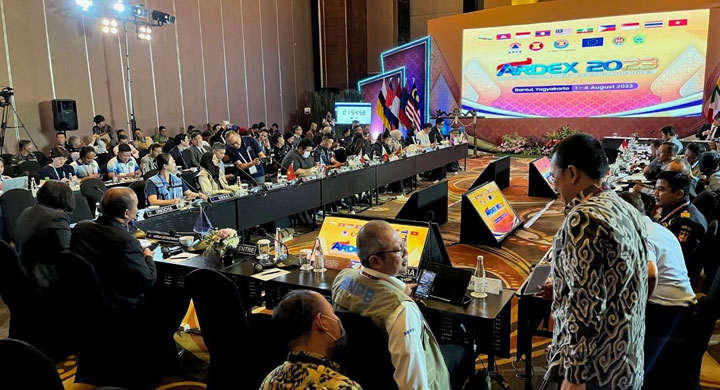
TTX exercise
From left (in front of the screen): NDMO from 9 AMS countries, ASEAN-ERAT, UNDAC.
From left in center: ASEAN Secretariat、AHA Centre、Indonesia NDMO(BNPB).
From inner right: Indonesia military, Indonesia MoH, MoFA, etc.
Behind the inner left side: Referees from AMS.
【Command Post Exercise (CPX)】
The command post exercise primarily targeted USAR teams, focusing on the coordination processes at the Emergency Operations Center (EOC) in the disaster-affected area. Participants reviewed the detailed scenario of the overall field exercise, including scheduled coordination meetings at the EOC. Additionally, briefings and exercises were conducted on essential procedures such as team registration, on-site coordination, and activity data management for USAR teams.
Since this was the first exercise conducted in preparation for the integration of the EMT SOP, the coordination mechanisms for EMTs were not fully addressed in the session. Instead, only a brief explanation was provided by the Health Division of the ASEAN Secretariat.
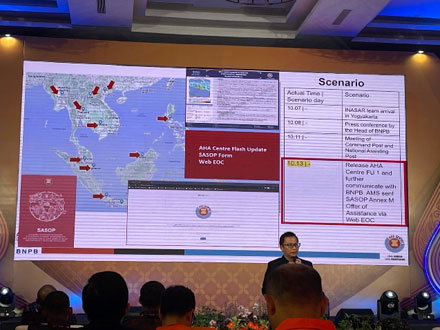
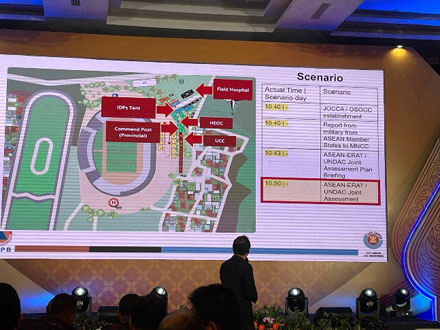
【Field Exercise (FTX)】
The field exercise was conducted at Sultan Agung Stadium on the outskirts of Yogyakarta. Following discussions with Indonesia’s medical team coordinators and domestic EMTs, the international EMTs from Thailand and the Philippines agreed to establish their operational base near an evacuation center, where they set up a temporary clinic.
Both Thai and Philippine EMTs brought their own activity reporting templates, leading to discussions to align their understanding and standardize documentation. While these teams demonstrated a clear understanding of ASEAN protocols and the EMT SOP, allowing them to integrate smoothly into the overall coordination framework, several challenges arose regarding the host country’s capacity to deploy and coordinate EMTs.
During the exercise, a task force member from the ARCH project, serving as a referee from the Thai Ministry of Health, provided feedback on key aspects such as the establishment of the EMT Coordination Cell (EMTCC), data management, and reporting procedures. This highlighted the need for additional efforts to ensure that standardized medical response procedures are widely disseminated within the ASEAN framework.
Given that only two international EMTs participated in the exercise, a mixed-team operational format was adopted. In real disaster scenarios within ASEAN, smaller EMTs may integrate into larger teams to form complementary operational units. Based on this experience, a proposal was made to incorporate procedures for mixed-team operations into the EMT SOP to better reflect potential real-world applications.
The next ARDEX is scheduled to take place in 2025. As ARDEX is hosted on a rotational basis by ASEAN member states, the next host country has yet to be determined.
Moving forward, it will be important to address the challenges identified in this exercise one by one. Within the project framework, we hope to explore possible approaches that can contribute to resolving these issues in preparation for the next ARDEX.
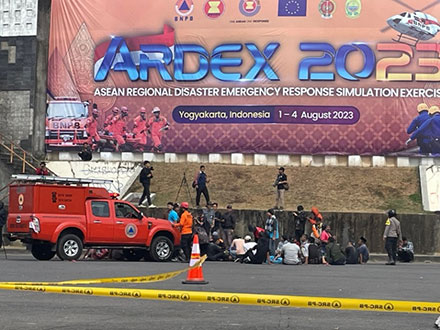
FTX site
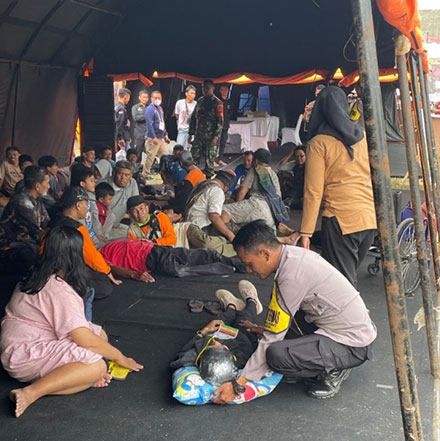
Shelter beside the EMT exercise site
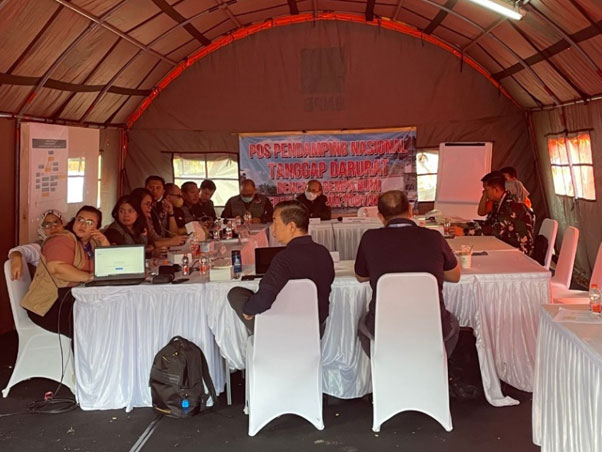
On-site Joint Operations and Coordination Centre of ASEAN (JOCCA)
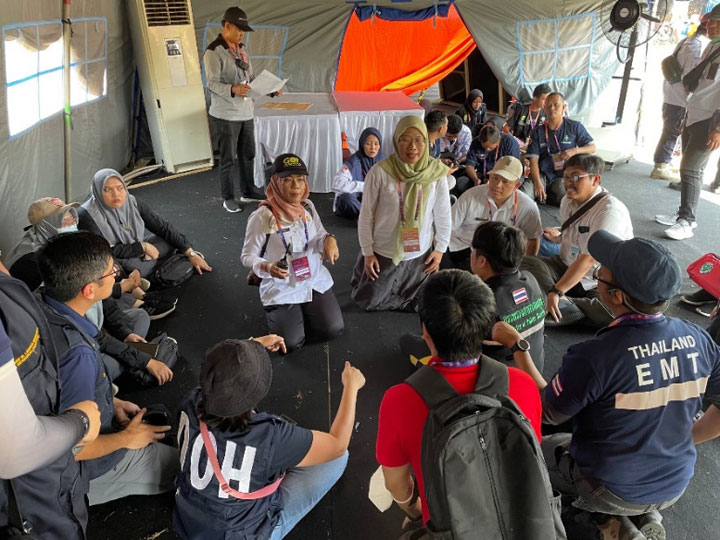
Briefing-meeting between local medical coordinator and EMT from the Philippines and Thailand
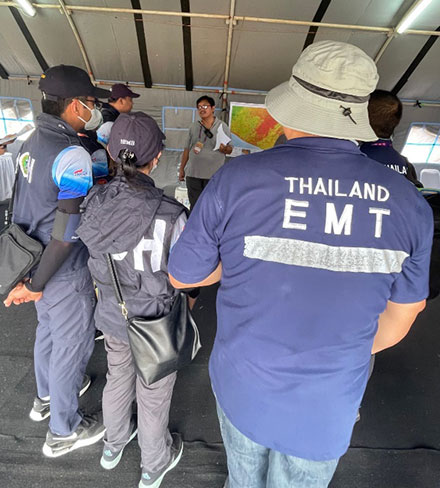
Sub-EMTCC meeting
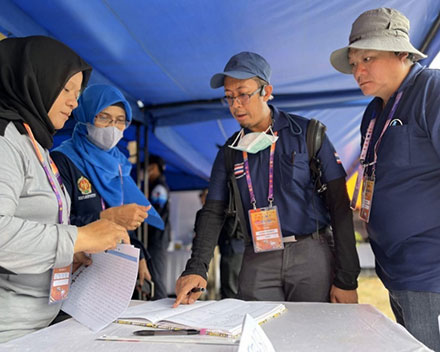
Checking the necessary documents and record
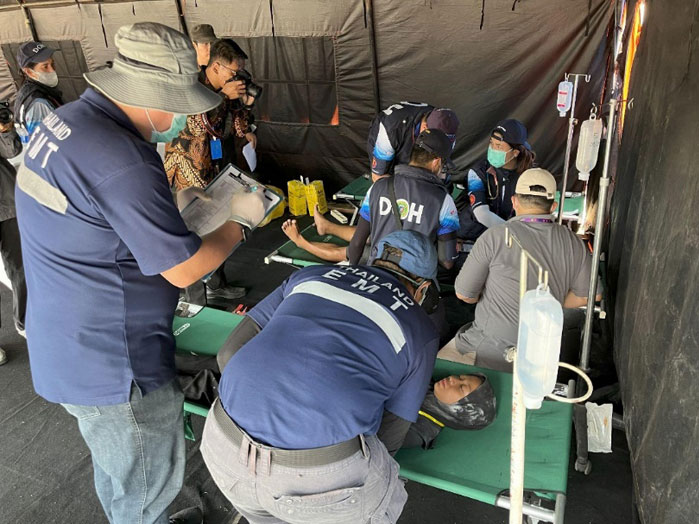
Medical operation (joint team)
